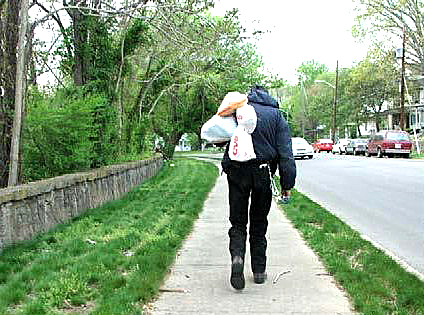Well-educated people either unemployed or under-employed are showing up in homeless shelters. The economy still remains sluggish, says the report on the homeless in the Roanoke region.
Many of those who experience homelessness over and over have alcohol, drug and mental health problems that are very difficult to address. The region has an excellent system of emergency and transitional housing and services.
Under funding has made it difficult to maintain a sufficient amount of quality, affordable housing in areas with good public transportation. The number of people identified in the 2012 Point-In-Time (PIT) count that took place in January is slightly higher than in 2010 and 2011.
For the third year the Community Housing Resource Center partners and the service referral network worked to stabilize the impact. The Blue Ridge Continuum of Care and the Roanoke Alleghany Regional Advisory Council on Homelessness worked diligently to use scarce resources. Creative new partnerships brought the Alleghany Highlands service providers into the network.
The U.S. Department of Housing and Urban Development (HUD) requires communities to conduct an annual point in time count [PIT] of sheltered and unsheltered people experiencing homelessness. The Virginia PIT occurs yearly on a single night in late January in each jurisdiction. The Roanoke Valley/Alleghany Regional Advisory Council on Homelessness is the lead entity for conducting the annual point-in-time count in the Roanoke region. The data collected provides valuable information to area service providers, policy makers, and the general public on the individual and family challenges and barriers associated with homelessness.
A report issued to the Virginia House Appropriations and Senate Finance Committees by the Virginia Department of Housing and Community Development states that in the annual 2011 point-in-time count conducted by localities statewide, at least 9,025 individuals were homeless during a 24-hour snapshot in January 2011. Four to five times that number may actually experience homelessness at some point during the year, according to national homeless studies. Many of these persons have special needs based on situations ranging from physical or mental disabilities to chronic substance abuse. Of the total homeless population, many are also victims of other circumstances such as job loss or domestic violence.
In 2012 the number of homeless in the Roanoke Region increased by 4.7% from 536 in 2011 to 561 in 2012. An inability to pay rent, lack of jobs and substance abuse problems were most often cited as reasons for being homeless. The 4.7% increase is calculated based on HUD’s counting criteria, which does not allow inclusion of the homeless who are counted in jails. There would actually be a decrease of one percent (6 people) this year (579) over last (585) if jailed populations were included in the count.
In the City of Roanoke, unemployment ranged from a high of 9.1% in January 2011 to 7.9% in December as compared to ranges of 6.9% to 6.1% in the Commonwealth of Virginia. These and other socio-economic indicators continue to be painful reminders of the effects of the economic downturn on vulnerable individuals and families, concluded the report.
Of those surveyed this year, 55.4% came to Roanoke in a homeless condition as a result of referrals, seeking services and shelter availability.
The annual point-in-time survey coupled with the use of the Homeless Management Information System (HMIS can determine whether the homeless population is increasing or decreasing. It is a tool to evaluate the effectiveness of programs and strategies in place to help address the issue of homelessness.
Included in the Point-in-Time survey for this year are homeless individuals who were also surveyed as part of the Virginia Coalition to End Homelessness [VCEH] 1000 Homes for 1000 Virginians initiative. The goal of the initiative is to identify and house the most vulnerable homeless people. These individuals cycle between the streets, emergency shelters, hospital emergency rooms, incarceration and mental health facilities. The combination of poor health status, mental health and/or substance abuse issues and homelessness make them far more likely to die while living on the streets. Jefferson College of Health Sciences Physician Assistant students administered the 100,000 Homes Vulnerability Index. The instrument will be used prioritize those individuals that have been homeless the longest.
Of these 561 individuals who were homeless 240 homeless adults participated in the PIT survey process. Children under the age of 18 were not surveyed. 100% of shelters elected to participate in the survey.
Seventeen people surveyed who were experiencing homelessness on the streets met the Vulnerability Index criteria. These individuals reported 45 emergency room visits in the previous three months and 14 inpatient hospitalizations in the past year. Many have suffered physical attacks. Three individuals were in need of immediate housing due to their medically vulnerability condition.
A by-name registry will be used to track these individuals from one year to the next. The survey is confidential and will serve to identify new strategies for adequate housing.



